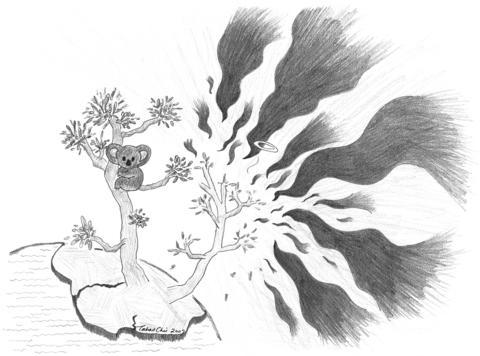Extreme drought, ferocious bushfires and urban development are killing Australia's koalas and could push the species towards extinction within a decade, environmentalists are warning.
Alarms about the demise of the iconic and peculiar animal, which sleeps about 20 hours per day and eats only the leaves of the eucalyptus tree, have been raised before.
But Deborah Tabart, chief executive officer of the Australia Koala Foundation, believes the animal's plight is as bad as she has seen it in her 20 years as a koala advocate.

"In southeast Queensland we had them listed as a vulnerable species which could go to extinction within 10 years. That could now be seven years," she said. "The koala's future is obviously bleak."
Southeastern Queensland has the strongest koala populations in the vast country, meaning extinction in this area spells disaster for the future of the species, Tabart said.
The biggest threat is the loss of habitat as a result of road building and development on Australia's eastern coast -- traditional koala country. The joke, Tabart said, is that koalas enjoy good real estate and are often pushed out of their habitat by farming or development.
"I've driven pretty much the whole country and I just see environmental vandalism and destruction everywhere I go," she said. "It's a very sorry tale. There are [koala] management problems all over the country."
Massive bushfires which raged in the country's south for weeks during the Australian summer, burning a million hectares of land, would also have killed thousands of koalas.
Meanwhile there is the worst drought in a century, genetic mutations from decades of inbreeding in some populations, and the widespread incidence of chlamydia, a type of venereal disease which affects fertility, to further cut koala numbers.
Moreover, the animals are often fatally attacked by pet dogs.
"In southeast Queensland the koalas are just in people's backyards and the dogs just munch on them," Tabart said.
Confusing the issue is the lack of data on the number of koalas in the wild. Figures range from 100,000 animals to several million. What is known is that there were once millions of them ranged along eastern Australia.
The hunting and slaughter for their furs in the 1920s eradicated the species in the state of South Australia and pushed Victorian populations close to extinction.
Public outrage over the killing of the big-eyed "bears" put an end to the practice but Victorian stocks were unfortunately later replenished with in-bred animals, leading to a lack of genetic diversity in that state.
As a result, genetic problems such as missing testicles and deformed "pin" heads have emerged in Victorian koalas, said University of Queensland academic Frank Carrick.
Carrick, who leads a koala study project at the university, estimates the national population of the marsupial at about 1 million. And while he doesn't believe the animal will be extinct within a decade, he acknowledges that numbers are contracting.
"Though we don't really have an accurate figure on how many koalas there are in Australia right now, we do know one thing -- that it's going down. Because we keep chopping down trees and their food source," he said.
Carrick said it will take 40 to 50 years for the koala to sufficiently recover from the impact of the latest Victorian bushfires, drought and development.
"Exactly how small do we want the population to be before we push the panic button?" he said.
Dan Lunney, a senior research scientist with the New South Wales (NSW) state Department of Environment and Conservation, said koalas cover roughly the same territory as they did 20 years ago.
In some areas -- Victoria state and Kangaroo Island in South Australia -- koala numbers are growing. But in New South Wales, which tracks the east coast of Australia, the koala is a recognized threatened species.
"That means if nothing is done about it the population will continue to decline," he said. "The issue is not how many there are; but it's whether they are declining or not."
Lunney said while the Victoria bushfires would have killed large numbers of animals, as long as some koalas survived and sufficient bush regrowth is maintained, the population will recover.
"Koalas can take a fair bit. That's why we've still got them," he said. "But they do have a threshold at which they can't continue."
Lunney said populations were at most risk of dying out in areas where new houses were being built, putting them at risk of death by cars and dogs.
"Koalas in the NSW coastal areas are the most vulnerable because that's where the human population is increasing," he said.
"As the human population increases on the North Coast, the cost is coming out in the survival of koalas. Road kill -- it's a common way to see wildlife," Lunney said.
Drought, fire and flood have always been part of the Australian environment, "but when your habitat is fragmented, all these things are exacerbated," said Erna Walraven, senior curator at Sydney's Taronga Zoo.
Walraven sees the koala as a flagship species, with the health of their populations serving as an indicator of the wider health of the wildlife of the bush, including bandicoots and wallabies.
"My view is that there are a range of animals under that five, six, seven kilogram range that really [are] quite vulnerable to increased development and land clearing on the coast," she said. "I think that the koala is in there with a big suite of other species, native Australian icons, that are under threat."

There are moments in history when America has turned its back on its principles and withdrawn from past commitments in service of higher goals. For example, US-Soviet Cold War competition compelled America to make a range of deals with unsavory and undemocratic figures across Latin America and Africa in service of geostrategic aims. The United States overlooked mass atrocities against the Bengali population in modern-day Bangladesh in the early 1970s in service of its tilt toward Pakistan, a relationship the Nixon administration deemed critical to its larger aims in developing relations with China. Then, of course, America switched diplomatic recognition
The international women’s soccer match between Taiwan and New Zealand at the Kaohsiung Nanzih Football Stadium, scheduled for Tuesday last week, was canceled at the last minute amid safety concerns over poor field conditions raised by the visiting team. The Football Ferns, as New Zealand’s women’s soccer team are known, had arrived in Taiwan one week earlier to prepare and soon raised their concerns. Efforts were made to improve the field, but the replacement patches of grass could not grow fast enough. The Football Ferns canceled the closed-door training match and then days later, the main event against Team Taiwan. The safety
The Chinese government on March 29 sent shock waves through the Tibetan Buddhist community by announcing the untimely death of one of its most revered spiritual figures, Hungkar Dorje Rinpoche. His sudden passing in Vietnam raised widespread suspicion and concern among his followers, who demanded an investigation. International human rights organization Human Rights Watch joined their call and urged a thorough investigation into his death, highlighting the potential involvement of the Chinese government. At just 56 years old, Rinpoche was influential not only as a spiritual leader, but also for his steadfast efforts to preserve and promote Tibetan identity and cultural
Strategic thinker Carl von Clausewitz has said that “war is politics by other means,” while investment guru Warren Buffett has said that “tariffs are an act of war.” Both aphorisms apply to China, which has long been engaged in a multifront political, economic and informational war against the US and the rest of the West. Kinetically also, China has launched the early stages of actual global conflict with its threats and aggressive moves against Taiwan, the Philippines and Japan, and its support for North Korea’s reckless actions against South Korea that could reignite the Korean War. Former US presidents Barack Obama